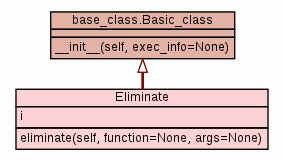Elimination or rejection of models.
Keyword Arguments
~~~~~~~~~~~~~~~~~
function: A user supplied function for model elimination.
args: A tuple of arguments for model elimination.
Description
~~~~~~~~~~~
This is used for model validation to eliminate or reject models prior to model selection. Model
validation is a part of mathematical modelling whereby models are either accepted or rejected.
Empirical rules are used for model rejection and are listed below. However these can be overridden
by supplying a function in the prompt and scripting modes. The function should accept five
arguments, a string defining a certain parameter, the value of the parameter, the minimisation
instance (ie the residue index if the model is residue specific), and the function arguments. If
the model is rejected, the function should return True, otherwise it should return False. The
function will be executed multiple times, once for each parameter of the model.
The 'args' keyword argument should be a tuple, a list enclosed in round brackets, and will be passed
to the user supplied function or the inbuilt function. For a description of the arguments accepted
by the inbuilt functions, see below.
Once a model is rejected, the select flag corresponding to that model will be set to False so that
model selection, or any other function, will then skip the model.
Local tm model elimination rule
~~~~~~~~~~~~~~~~~~~~~~~~~~~~~~~
The local tm, in some cases, may exceed the value expected for a global correlation time. Generally
the tm value will be stuck at the upper limit defined for the parameter. These models are
eliminated using the rule:
tm >= c
The default value of c is 50 ns, although this can be overridden by supplying the value (in seconds)
as the first element of the args tuple.
Internal correlation times {te, tf, ts} model elimination rules
~~~~~~~~~~~~~~~~~~~~~~~~~~~~~~~~~~~~~~~~~~~~~~~~~~~~~~~~~~~~~~~
These parameters may experience the same problem as the local tm in that the model fails and the
parameter value is stuck at the upper limit. These parameters are constrained using the formula
(te, tf, ts <= 2tm). These failed models are eliminated using the rule:
te, tf, ts >= c . tm
The default value of c is 1.5. Because of round-off errors and the constraint algorithm, setting c
to 2 will result in no models being eliminated as the minimised parameters will always be less than
2tm. The value can be changed by supplying the value as the second element of the tuple.
Arguments
~~~~~~~~~
The 'args' argument must be a tuple of length 2, the elements of which must be numbers. For
example, to eliminate models which have a local tm value greater than 25 ns and models with internal
correlation times greater than 1.5 times tm, set 'args' to (25 * 1e-9, 1.5).
|

